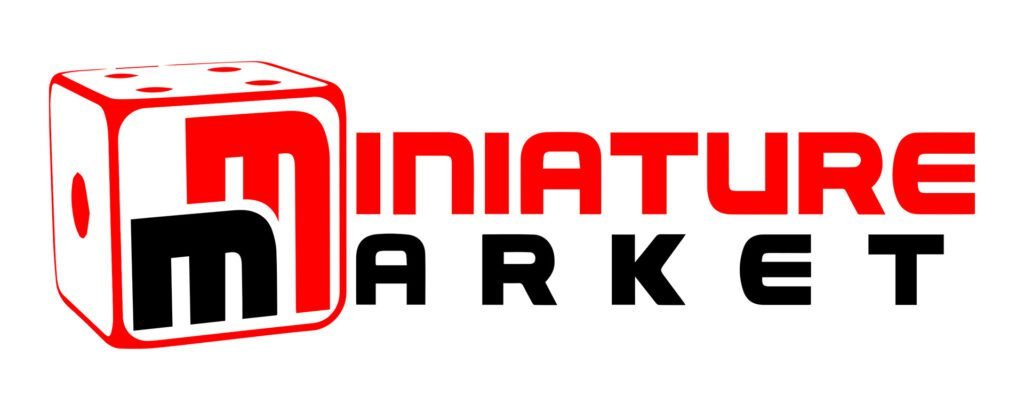
Today we’re diving into Stonespine Architects. This is a board game from Thunderworks Games set in their World of Ulos universe, and it’s all about dungeon building with some fresh twists. So, let’s break it down – what it is, what’s good, what’s bad, and if you should pick it up. Let’s get into it.
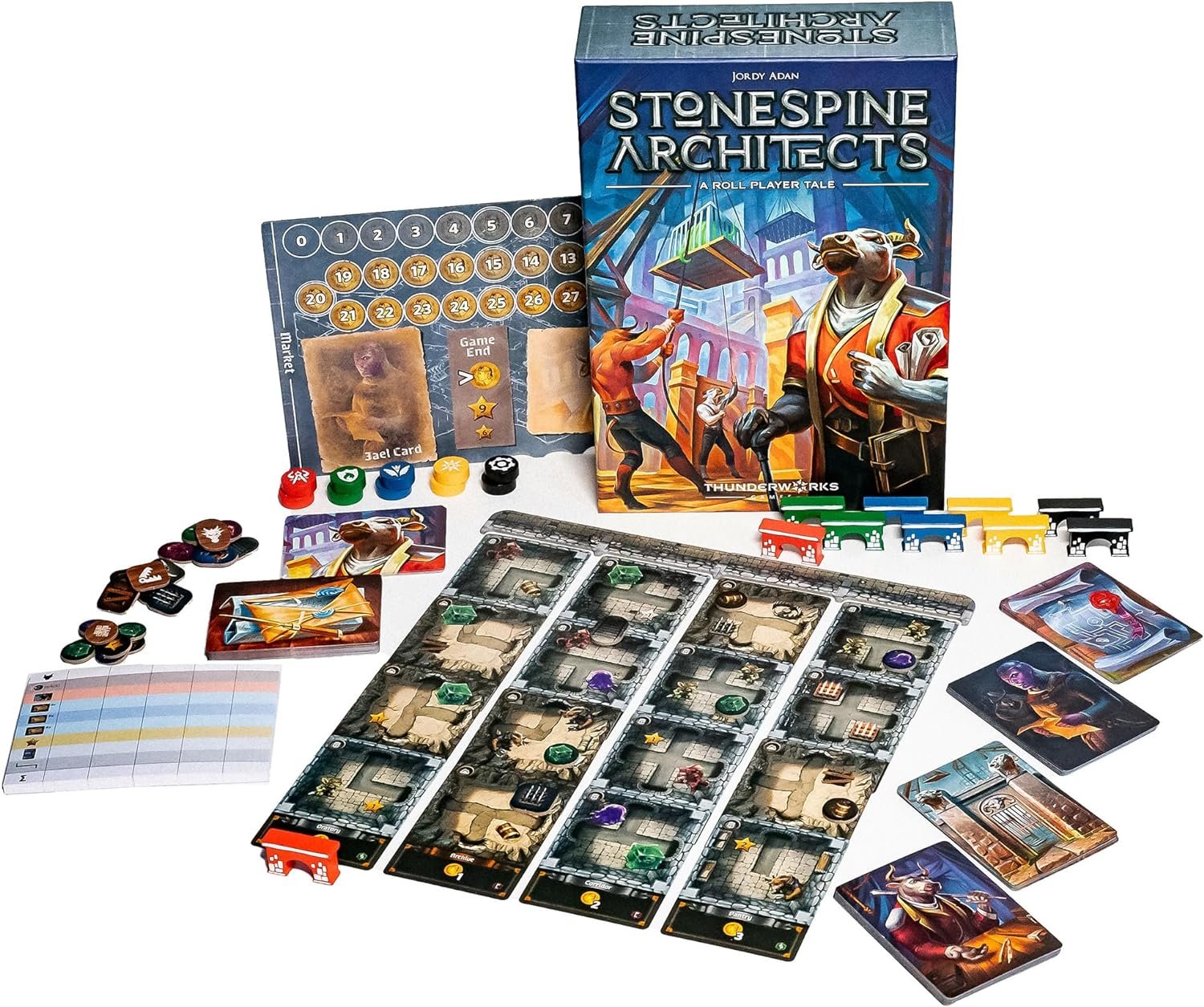
What It Is
Stonespine Architects is a medium-weight dungeon-building game where players are tasked with constructing a 4×4 grid dungeon over the course of four rounds. Players draft and place cards that represent different dungeon elements like treasure chests, traps, and characters, with the goal of scoring points based on how well they design their dungeon. While the game is set in the same universe as other Thunderworks titles like Roll Player and Cartographers, the focus here is entirely on maximizing point-scoring through clever card placement and objective fulfillment, rather than seeing adventurers explore your dungeon.
Check Out These Recent Board Game Sales
- Board Game Sale: Disney Villainous 25% Off!
- Board Game Sale: Marvel: Crisis Protocol Core Set 30% Off!
- Board Game Sale: 7 Wonders Available for 17% Off!
Gameplay Overview
In Stonespine Architects, your goal is to design and construct the most intricate and formidable dungeon, earning the esteemed title of Master Architect. The game unfolds over four rounds, known as years, with each year split into three distinct phases: Construction, Improvement, and Cleanup.
To begin, each player is given a dungeon frame, a player reference card, tracking markers, and doorway pieces. A central tracking board is placed on the table to monitor gold accumulation and player priority. Players are also dealt goal and challenge cards based on player count, while market tokens and cards are set up for later phases. Each player receives a blueprint and five chamber cards, which will be used to build their dungeon.
By the end of the game, each dungeon will form a 4×4 grid of chamber cards. Each chamber card represents either a cave or stone type and includes a gold value. Chambers can feature doors, paths, and various elements, such as traps, monsters, treasure chests, and reputation stars. A maximum of four elements can be placed in any chamber, adding complexity to dungeon construction.
During the Construction phase, players simultaneously choose and reveal a chamber card from their hand to add to their dungeon. In a two-player game, players choose two cards—one for placement and one for discard. After placing their chambers, players pass their remaining cards to their neighbor, rotating clockwise in odd-numbered years and counterclockwise in even-numbered years. This drafting process continues until four chambers are placed each year.
The Improvement phase kicks off by calculating gold. Players tally the gold values of their newly completed row of chambers, with an additional gold for each treasure chest in their dungeon. They then advance their markers on the gold track, which determines turn order for the upcoming market phase. The player with the most gold selects first, choosing to either buy tokens or pass. Tokens represent extra elements that can be added to chambers, and a special token, the secret passage, allows players to connect chambers with previously disconnected paths.
When a player chooses to pass, their gold marker resets to zero, and they select a challenge card. They also move their priority marker to the leftmost open space on the priority track, determining their position for the following year’s turn order. The Cleanup phase follows, refreshing the market, revealing new challenge cards, and dealing new chamber cards to players. This process repeats for four years as players expand their dungeons row by row.
At the end of the fourth year, final scoring begins. Players place their second doorway piece to mark their dungeon’s exit, and points are calculated using reputation stars, challenge cards, and their position on the priority track. The goal card provides bonus points to players who best fulfill its specific conditions, such as having the most traps or monsters in their dungeon. Challenge cards offer additional points when their criteria are met, which may involve specific elements or chamber arrangements.
Clusters of adjacent chambers of the same type become particularly important for scoring certain challenge cards. Players also score for the longest continuous path in their dungeon, connecting the entrance and exit, with each chamber along this path earning points. Additional points come from reputation stars printed on chambers or added through tokens, and players receive extra points for having multiple unique monster types in their dungeon.
Finally, players lose points for any empty spaces in their dungeon that should have been filled with chamber cards. After all points are tallied, the player with the highest score claims the title of Master Architect and wins the game.
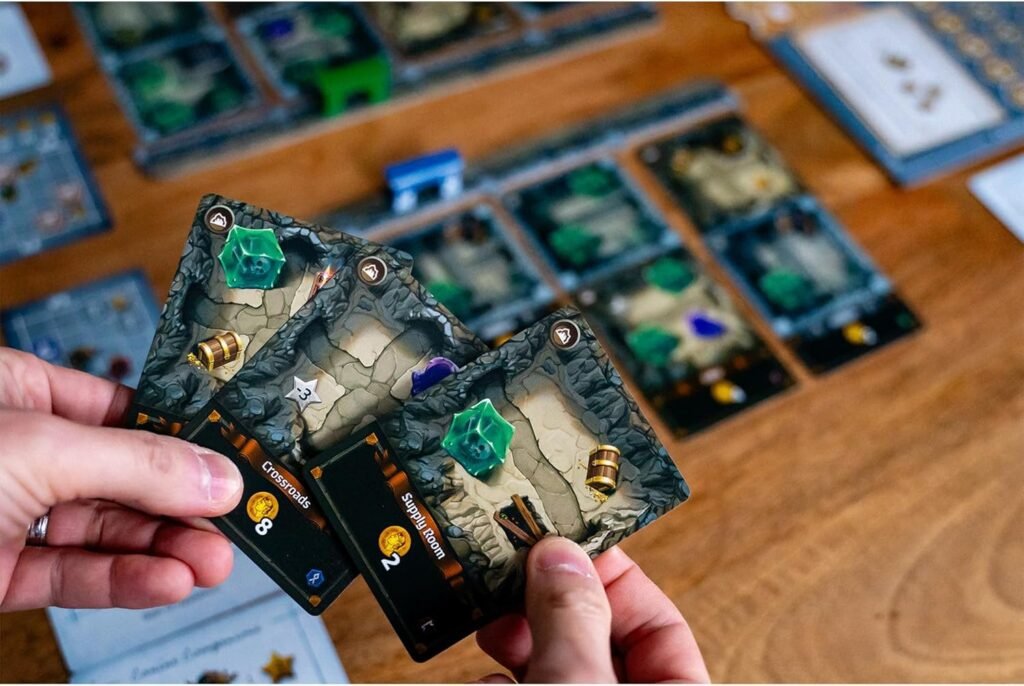
The Components
The visual design of Stonespine Architects is striking, with a clean and colorful art style that fits perfectly within its dungeon-building theme. The cards are well-designed, with clear iconography that makes it easy to track scoring and effects at a glance. The 16-card dungeon grid looks satisfying as it comes together, creating a visually cohesive dungeon layout that also serves as a tactile representation of your progress.
The tokens and cards are high-quality, and the overall production value contributes to the game’s immersion. It’s a game that looks great on the table and is easy to set up and tear down, making it a great option for shorter, filler game sessions. The box size is compact, and the components are well-organized, which adds to the overall appeal of the game.
The Good
One of the biggest strengths of Stonespine Architects is its accessibility. The core mechanics are straightforward, making it easy to teach and learn, yet the game offers enough strategic depth to keep both casual and experienced gamers engaged. The card placement feels intuitive, and the blueprint system introduces a satisfying puzzle-like challenge as players try to connect the entrance and exit while maximizing point-scoring opportunities. The market phase adds an extra layer of player interaction, where decisions can significantly impact the outcome of the game, and it’s a nice change of pace from the usual solitary puzzle-solving of tile-laying games.
Another great feature is the fast playtime. Stonespine Architects wraps up in about 30-45 minutes, making it a perfect game for weeknights or as a warm-up for longer gaming sessions. It offers just enough strategic depth to satisfy without overstaying its welcome, which is always a plus when time is limited. The game also includes a well-balanced two-player variant that introduces a “hate drafting” element, adding a competitive edge to the game that enhances its replayability in smaller groups.
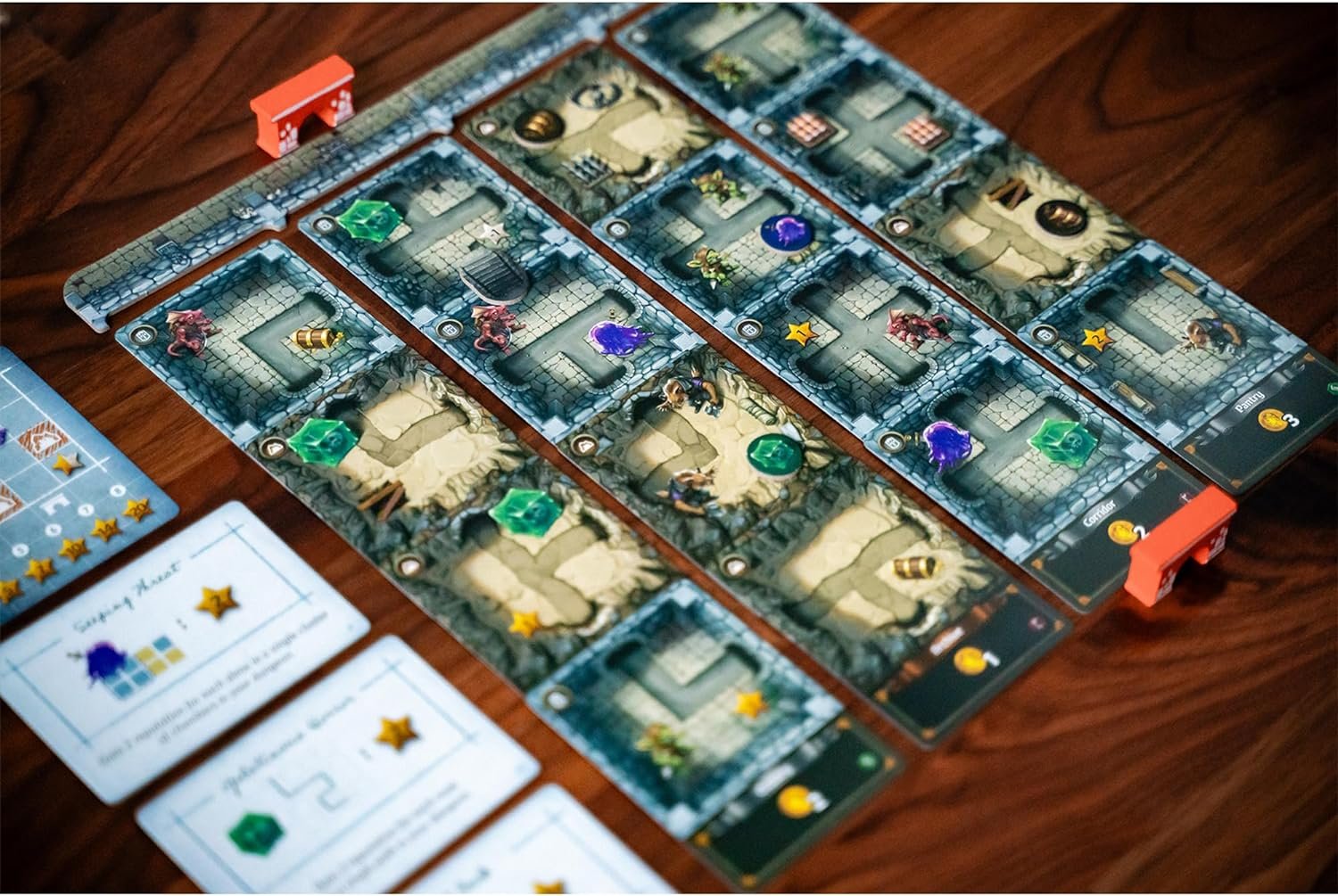
The Bad
However, the game does have a few drawbacks. Some players may find the blueprint objectives too easy to complete, especially for experienced gamers looking for more of a challenge. This ease of accomplishment can make the game feel less rewarding, as players may breeze through the objectives without having to work too hard for their points. The game’s focus on efficiency and quick turns sometimes limits the depth of planning, especially for those who prefer more complex or tactical gameplay.
Additionally, the luck of the draw in card drafting can occasionally limit strategic options. If a round’s draft doesn’t present many useful cards, players may feel like their choices are being dictated by luck rather than skill. This issue can be exacerbated by the game’s short length, where each card placement is crucial, and the variance in scoring from challenge cards can sometimes feel swingy, leading to point disparities that might frustrate players who feel their careful planning is overshadowed by luck.
The Verdict
Stonespine Architects is a solid entry into the dungeon-building genre with its accessible mechanics, quick playtime, and satisfying puzzle elements. The game shines when it comes to ease of learning and player interaction, particularly with its market phase, which adds a layer of competition that elevates it beyond just a card-placement game. It’s a great option for gamers looking for a light-to-medium weight game that plays quickly and still offers enough strategic depth to be engaging.
That said, it might not offer the depth or challenge that more experienced gamers crave. The blueprint objectives can feel too simple, and the reliance on luck in card drafting may lead to uneven experiences from game to game. However, for casual gaming sessions or a quick filler game that still packs a punch, Stonespine Architects fits the bill nicely. The two-player variant adds another dimension to the game, making it a bit more cutthroat and adding to its replayability in smaller groups.
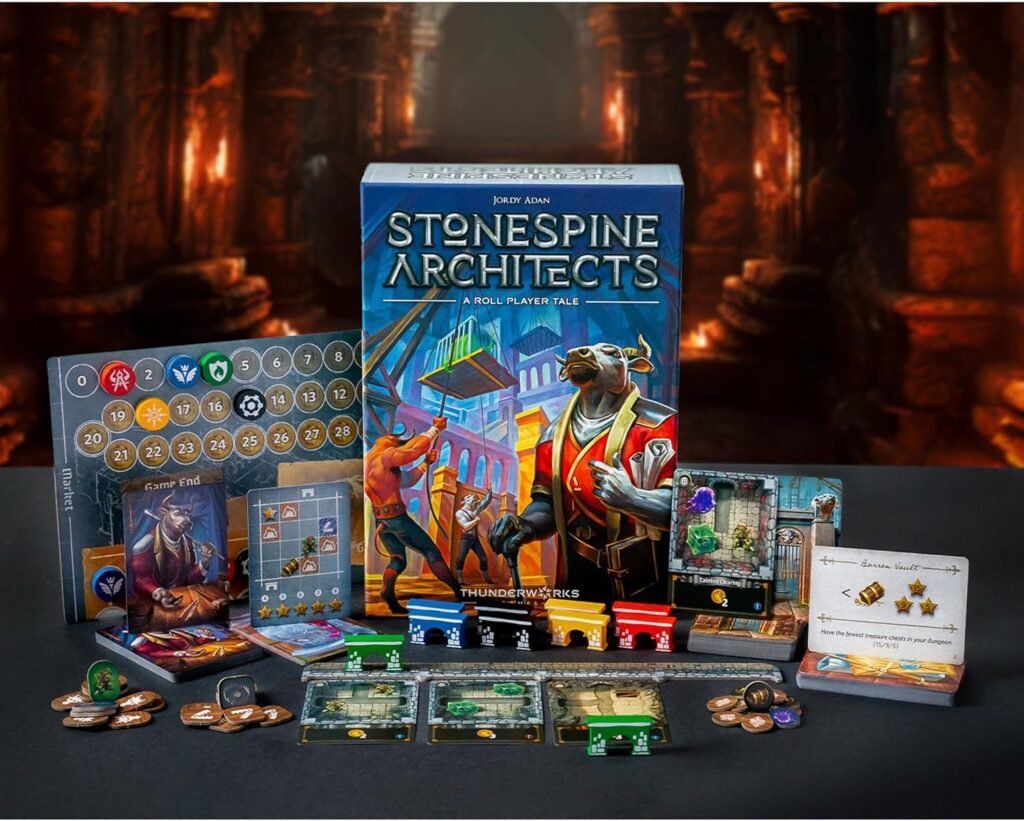
Final Thoughts
Alright, so here’s where I land with Stonespine Architects after playing it a few times. I actually had a pretty good time with it, and it fits into that sweet spot of being easy to teach and fast to play, which is great when you’re looking for something to fill the gap between heavier games or if you’re just in the mood for something lighter. The dungeon-building theme is really fun, and there’s something satisfying about laying out your perfect little grid and watching it all come together. It’s not a brain-burner by any means, but that’s part of the charm.
What stood out to me was how simple it is to get going. You’re placing cards, building out your dungeon, and keeping an eye on your objectives, but nothing feels too overwhelming. There’s a bit of a puzzle in how you connect everything, especially trying to maximize points by lining up those entrances and exits, but it never feels like it’s going to fry your brain. Plus, the market phase adds a nice layer of strategy without bogging things down—deciding when to grab certain tokens or challenge cards can really swing things in your favor, which keeps it engaging.
That said, there are a couple of small things that bugged me. The blueprint objectives are pretty easy to hit, so after a while, I felt like I wasn’t being pushed to really think outside the box. It’s not a dealbreaker, but for players who like a little more of a challenge, this might feel a bit too forgiving. And yeah, there’s definitely some luck in the card draw. Sometimes you just don’t get the cards you need, and that can be frustrating when you’re trying to work towards a specific plan. But hey, that’s drafting games for you, right?
Now, I will say, I loved how quick this game moves. We were finishing games in about 30-40 minutes, which is perfect if you don’t have a lot of time or just want something breezy to start or end a game night. You’re not locked into a long, drawn-out experience, but there’s still enough going on to keep everyone interested. I can see myself pulling this out as a warm-up or wind-down game more than anything else.
One thing I found fun was how the game looked when you’re done. There’s something really cool about seeing your 4×4 dungeon laid out, and the art is nice enough that it helps pull you into the theme a bit. It’s not the kind of game that’s going to blow you away with production value, but it’s clean, it’s clear, and it works for what it is.
Overall, Stonespine Architects does what it sets out to do. It’s not the most complex game out there, and it’s not trying to be. It’s light, it’s fast, and it scratches that itch for a quick, strategic game when you don’t want to dive into something too heavy. If you’re into dungeon-building or just like the sound of a shorter, snappier experience, this one’s worth checking out. I wouldn’t say it’s a must-have for everyone, but I’m glad it’s in my collection for those nights when I want something that’s easy to get to the table but still gives me some fun decisions to make.
Purchase Options

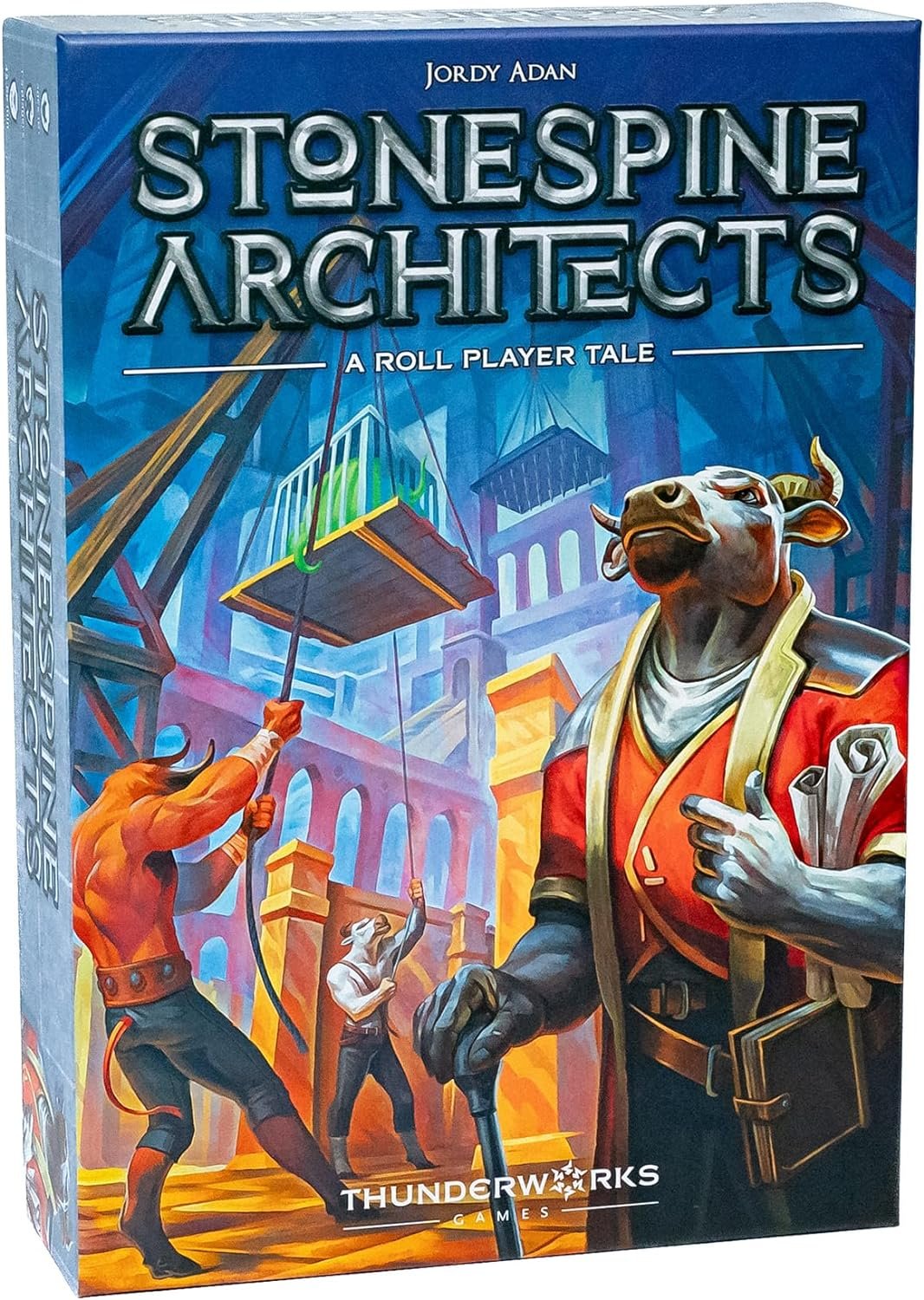
At no extra cost to you, The Board Game Site may receive revenue from affiliate and advertising partnerships for sharing this content and from purchases through links.



